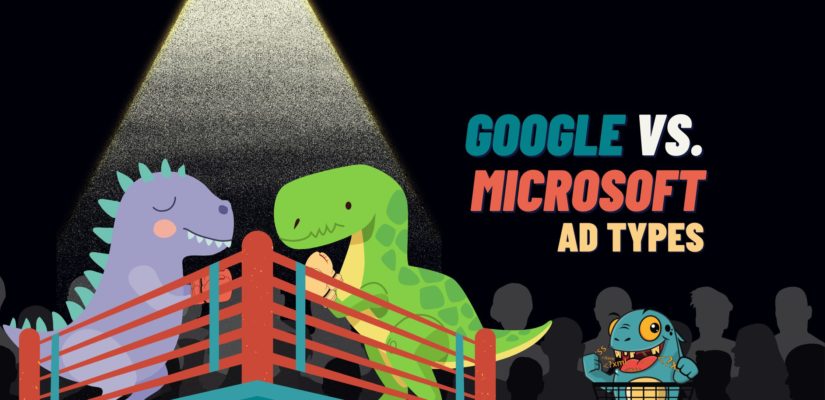
Google Vs Microsoft Ad Types
When it comes to marketing your or your client’s products, it’s important to consider the types of adverts that display on various channels, and how they impact audiences.
This article will outline the types of Google and Microsoft ad campaigns and the various features of each one.
Which ad type is the right one for you?
What are Microsoft Ads?
Microsoft Ads consist of campaigns that appear on the Microsoft Audience Network, including Bing and Yahoo.
Microsoft Ad Types
Here are the Types of Microsoft Ads you can create on Microsoft Advertising:
Dynamic Search Ads
These are dynamically created to respond to your customers’ search queries using expanded text.

Bing Smart Search
These include a preview of your landing page (Only available to US, UK and Canada)
Microsoft Audience Ads
These ads appear on the Microsoft Audience Network and display on non-search placements like MSN, Outlook.com and other Microsoft Partners.

Multimedia Ads
These ad types include images to send traffic to your website. These can be in animated and video format too.
Product Ads
These are promotional adverts that that include your product image, pricing and your promotional text.

You can find out all you need to know about Using Microsoft Ads.
What are Google ads?
Google ads display on Google Search Partners, like Youtube, or Google’s Display Network with the goal of driving traffic to your store.
At the core of this model is the Google search network. This network is where customers are looking for products or services, and where merchants can list these products and services. Google’s search network relies on optimized keywords that specify how specific the items are – this is important for your audience.
Learn more about Google Ads Display Network here.
Google Ad Types
Here are some Google Ad Types in 2022:
Search Ads
Otherwise known as responsive search ads, these are campaigns that display on Google Results page.
A branded Google Ad will appear on the search engine when customers search your product by brand name, a non-branded search advert will appear when your customer searches by product.

Google Display Ads
These are ads that go directly to the Google Search Network, which are Google partners whom opt in to display Google Ads (Including Google Maps). Ultimately, these are ads display on another webpage to draw attention away from the website content.
Video Ads
These advert types display on Youtube and are in the form of multimedia and video ads, many of which show up on Youtube.
Shopping Ads
These ads can typically show up under the “shopping” tab in your Google Search Engine and is pulled from Google Merchant Center with your product data feed. It always includes the price and the image of the product.

A quick note on Google Shopping Ads: Smart Shopping Campaigns have been replaced by Performance Max campaigns, where you can set goal-orientated adverts that track your campaign’s performance. These Google Campaign types use machine learning to target audiences at optimal bids.
What are the differences between Microsoft Ads and Google ad types?
Both Microsoft and Google ads adhere to a Cost-per-click (CPC) pricing model, which is when advertisers pay a fee every time someone clicks their advert. Microsoft CPC rates are lower than Google Ads display at the top of the search results page, resulting in a 45% higher click-through-rate (CTR) than Google ads.
Microsoft allows you to target according to demographics, geolocation and type of device used. 85% of people who use Bing live in the US. Microsoft Ads therefore have a narrower and more niche audience than Google Ads. Given the narrower audience, Microsoft Ads reaches fewer consumers than Google but that doesn’t mean it will impact leads, in fact Microsoft ads have a higher CTR than Google.
Which channel is better?
When deciding whether to use Google Shopping Ads or Microsoft Shopping Ads, it all comes down to knowledge about your audience. If your audience is predominantly from the USA, choosing Microsoft Ads would certainly come to your advantage.
Another thing to consider is how you would like to compete in the eCommerce market – if you’re looking to sell to a very niche and specific audience, Bing Shopping Ads is your best bet.
Ultimately, Google Shopping’s biggest competitor is Facebook ads, sharing similar audience sets. Keep in mind the availability and accessibility of your audiences when creating your shopping campaigns.
What is the best approach?
Why choose one of these campaign types when you can have them all?
A blended advertising campaign can work to your advantage in that adverts displayed on multiple channels work in a complementary way.
Using a multi-channel strategy can amp up your, or your clients’, ad campaigns for the following reasons:
- You can monitor your ads to see what is and what isn’t working
- You can track audience responses
- You can sell to both a wide set and niche set of audiences
- You can achieve better results and fulfill your and your client’s business objectives.
With ShoppingFeeder, you can simply integrate your WooCommerce or Shopify stores to both Google, Microsoft, and Facebook (among others) to amp up your campaigns.
Chat to our experts at ShoppingFeeder to learn more and if you’re an agency, working on behalf of clients consider subscribing to FeedNexus for Agencies for single-log in access to all your various stores.
Final Verdict
Knowing your ad types, be it for Google Ads, Microsoft Shopping or Facebook catalog, is an important way to establish how you are going to reach particular audiences and showcase your products.
Instead of viewing each channel as competitors, it is better for your overall ROAS and business goals to display your product ads on varying platforms as complements to one another.
With ShoppingFeeder’s sophisticated platform, you can get the best of all worlds.

